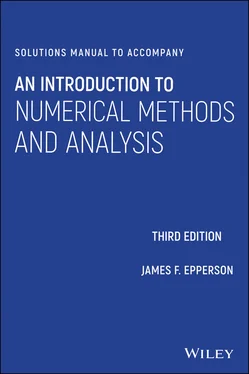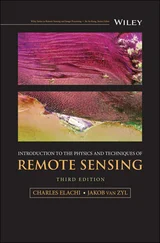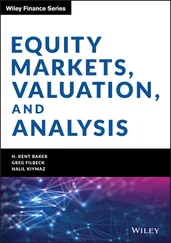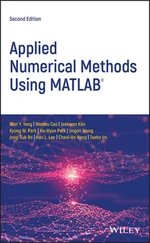James F. Epperson - Solutions Manual to Accompany An Introduction to Numerical Methods and Analysis
Здесь есть возможность читать онлайн «James F. Epperson - Solutions Manual to Accompany An Introduction to Numerical Methods and Analysis» — ознакомительный отрывок электронной книги совершенно бесплатно, а после прочтения отрывка купить полную версию. В некоторых случаях можно слушать аудио, скачать через торрент в формате fb2 и присутствует краткое содержание. Жанр: unrecognised, на английском языке. Описание произведения, (предисловие) а так же отзывы посетителей доступны на портале библиотеки ЛибКат.
- Название:Solutions Manual to Accompany An Introduction to Numerical Methods and Analysis
- Автор:
- Жанр:
- Год:неизвестен
- ISBN:нет данных
- Рейтинг книги:4 / 5. Голосов: 1
-
Избранное:Добавить в избранное
- Отзывы:
-
Ваша оценка:
- 80
- 1
- 2
- 3
- 4
- 5
Solutions Manual to Accompany An Introduction to Numerical Methods and Analysis: краткое содержание, описание и аннотация
Предлагаем к чтению аннотацию, описание, краткое содержание или предисловие (зависит от того, что написал сам автор книги «Solutions Manual to Accompany An Introduction to Numerical Methods and Analysis»). Если вы не нашли необходимую информацию о книге — напишите в комментариях, мы постараемся отыскать её.
Solutions Manual to Accompany An Introduction to Numerical Methods and Analysis — читать онлайн ознакомительный отрывок
Ниже представлен текст книги, разбитый по страницам. Система сохранения места последней прочитанной страницы, позволяет с удобством читать онлайн бесплатно книгу «Solutions Manual to Accompany An Introduction to Numerical Methods and Analysis», без необходимости каждый раз заново искать на чём Вы остановились. Поставьте закладку, и сможете в любой момент перейти на страницу, на которой закончили чтение.
Интервал:
Закладка:
227 227
228 228
229 229
230 230
231 231
232 232
233 233
234 234
235 235
236 236
237 237
238 238
239 239
240 240
241 241
242 242
243 243
244 244
245 245
246 247
247 248
248 249
249 250
250 251
251 252
252 253
253 254
254 255
255 256
256 257
257 258
258 259
259 260
260 261
261 262
262 263
263 264
264 265
265 266
266 267
267 268
268 269
269 270
270 271
271 272
272 273
273 274
274 275
275 277
276 278
277 279
278 280
279 281
280 282
281 283
282 284
283 285
Solutions Manual to Accompany
An Introduction to Numerical Methods and Analysis
THIRD EDITION
James F. Epperson
Mathematical Reviews, American Mathematical Society

This third edition first published 2021 © 2021 John Wiley and Sons, Inc.
Edition History John Wiley & Sons, Inc. (2e, 2014)
All rights reserved. No part of this publication may be reproduced, stored in a retrieval system, or transmitted, in any form or by any means, electronic, mechanical, photocopying, recording or otherwise, except as permitted by law. Advice on how to obtain permission to reuse material from this title is available at http://www.wiley.com/go/permissions.
The right of James F. Epperson to be identified as the author of this work has been asserted in accordance with law.
Registered Office John Wiley & Sons, Inc., 111 River Street, Hoboken, NJ 07030, USA
Editorial Office 111 River Street, Hoboken, NJ 07030, USA
For details of our global editorial offices, customer services, and more information about Wiley products visit us at www.wiley.com.
Wiley also publishes its books in a variety of electronic formats and by print‐on‐demand. Some content that appears in standard print versions of this book may not be available in other formats.
Limit of Liability/Disclaimer of Warranty While the publisher and authors have used their best efforts in preparing this work, they make no representations or warranties with respect to the accuracy or completeness of the contents of this work and specifically disclaim all warranties, including without limitation any implied warranties of merchantability or fitness for a particular purpose. No warranty may be created or extended by sales representatives, written sales materials or promotional statements for this work. The fact that an organization, website, or product is referred to in this work as a citation and/or potential source of further information does not mean that the publisher and authors endorse the information or services the organization, website, or product may provide or recommendations it may make. This work is sold with the understanding that the publisher is not engaged in rendering professional services. The advice and strategies contained herein may not be suitable for your situation. You should consult with a specialist where appropriate. Further, readers should be aware that websites listed in this work may have changed or disappeared between when this work was written and when it is read. Neither the publisher nor authors shall be liable for any loss of profit or any other commercial damages, including but not limited to special, incidental, consequential, or other damages.
Library of Congress Cataloging‐in‐Publication Data is applied for ISBN: 9781119604532
Cover Design: Wiley
Preface to the Solutions Manual for the Third Edition
This manual is written for instructors, not students. It includes worked solutions for many (roughly 75%) of the problems in the text. For the computational exercises I have given the output generated by my program, or sometimes a program listing. Most of the programming was done in MATLAB, some in FORTRAN. (The author is well aware that FORTRAN is archaic, but there is a lot of “legacy code” in FORTRAN, and the author believes there is value in learning a new language, even an archaic one.) When the text has a series of exercises that are obviously similar and have similar solutions, then sometimes only one of these problems has a worked solution included. When computational results are asked for a series of similar functions or problems, only a subset of solutions are reported, largely for the sake of brevity. Some exercises that simply ask the student to perform a straightforward computation are skipped. Exercises that repeat the same computation but with a different method are also often skipped, as are exercises that ask the student to “verify” a straight‐forward computation.
Some of the exercises were designed to be open-ended and almost “essay‐like.” For these exercises, the only solution typically provided is a short hint or brief outline of the kind of discussion anticipated by the author.
In many exercises the student needs to construct an upper bound on a derivative of some function in order to determine how small a parameter has to be to achieve a desired level of accuracy. For many of the solutions this was done using a computer algebra package and the details are not given.
Students who acquire a copy of this manual in order to obtain worked solutions to homework problems should be aware that none of the solutions are given in enough detail to earn full credit from an instructor.
The author freely admits the potential for error in any of these solutions, especially since many of the exercises were modified after the final version of the text was submitted to the publisher and because the ordering of the exercises was changed between editions. While we tried to make all the appropriate corrections, the possibility of error is still present, and undoubtedly the author's responsibility.
Because much of the manual was constructed by doing “copy‐and‐paste” from the files for the text, the enumeration of many tables and figures will be different. I have tried to note what the number is in the text, but certainly may have missed some instances.
Suggestions for new exercises and corrections to these solutions are very welcome. Contact the author at jfe@ams.orgor jfepperson@gmail.com.
Differences from the textThe text itself went through a copy‐editing process after this manual was completed. As was to be expected, the wording of several problems was slightly changed. None of these changes should affect the problem in terms of what is expected of students; the vast majority of the changes were to replace “previous problem” (a bad habit of mine) with “Problem X.Y” (which I should have done on my own, in the first place). Some punctuation was also changed. The point of adding this note is to explain the textual differences which might be noticed between the text and this manual. If something needs clarification, please contact me at the above email.
CHAPTER 1 INTRODUCTORY CONCEPTS AND CALCULUS REVIEW
1.1 BASIC TOOLS OF CALCULUS
Exercises:
1 1. Show that the third‐order Taylor polynomial for , about , isSolution: We have andso that , , . Therefore,
1 2. What is the third‐order Taylor polynomial for , about ?Solution: We have andso that , , . Therefore
2 3. What is the sixth‐order Taylor polynomial for , using ? Hint: Consider the previous problem.
3 4. Given thatfor , where is between and 0, find an upper bound for , valid for all , that is independent of and .
Читать дальшеИнтервал:
Закладка:
Похожие книги на «Solutions Manual to Accompany An Introduction to Numerical Methods and Analysis»
Представляем Вашему вниманию похожие книги на «Solutions Manual to Accompany An Introduction to Numerical Methods and Analysis» списком для выбора. Мы отобрали схожую по названию и смыслу литературу в надежде предоставить читателям больше вариантов отыскать новые, интересные, ещё непрочитанные произведения.
Обсуждение, отзывы о книге «Solutions Manual to Accompany An Introduction to Numerical Methods and Analysis» и просто собственные мнения читателей. Оставьте ваши комментарии, напишите, что Вы думаете о произведении, его смысле или главных героях. Укажите что конкретно понравилось, а что нет, и почему Вы так считаете.












